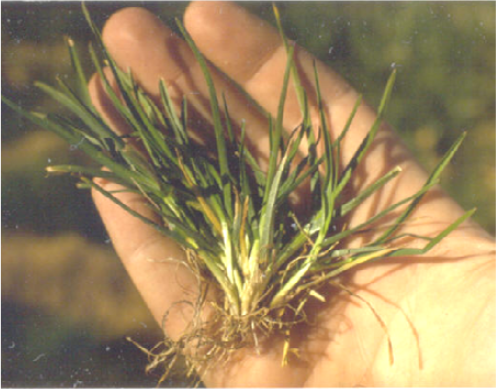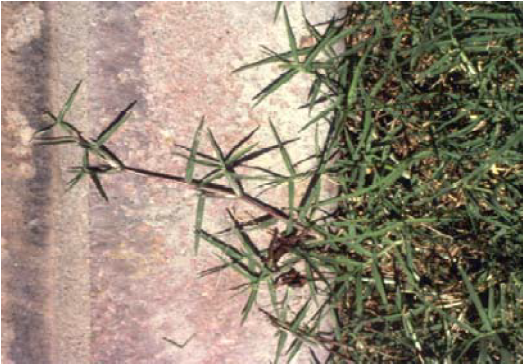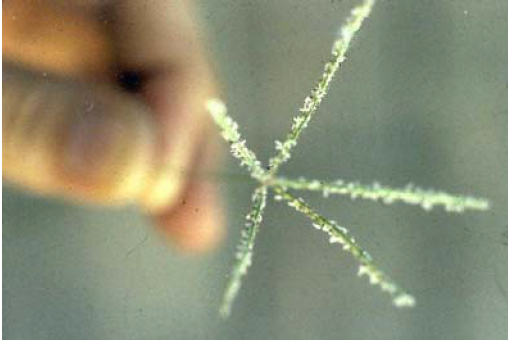Introduction
Turfgrasses can play an important role in desert landscapes. It is hard to imagine any other landscape surface that provides the same durability and safety for recreational activities. Turfgrass, or lawn grasses as they are sometimes referred to, have been recognized by Congress for their environmental benefits. "Turfgrass sod in urban areas and communities can aid in the reduction of carbon dioxide emissions, mitigating the heat island effect, reducing energy consumption and contributing to efforts to reduce global warming trends" (Qian,Yaling and Ronald F. Follett, 2002). In parts of the country where clean water is scarce and reuse water is being used more and more for irrigation, soil surfaces covered by healthy turfgrass provide an added safety factor to our clean water supply by removing nitrates and other pollutants that potentially plague it. The question isn’t WHETHER turfgrass should be used in desert communities or not but rather HOW turfgrass should be used appropriately.
Turfgrass is sometimes used inappropriately in desert climates. Never use turfgrass as a decorative groundcover to fill in unplanted areas (voids or negative spaces in landscape designs). These design voids, or negative spaces, are better left unplanted to reduce total landscape water use and maintenance. Never plant turfgrass irrigated with sprinklers on slopes greater than 3:1 (1 foot rise for every 3 feet of horizontal run). Planting turfgrass on slopes leads toward water waste due to runoff. Never plant turfgrass that is sprinkler-irrigated in landscape areas less than 8 feet wide due to poor uniformity of applied water to areas less than this. And finally turfgrasses should not be installed where overspray from overhead irrigation can damage homes and hardscapes and create runoff.

Figure 1. The bunching characteristic of a turfgrass plant.
Sod Forming vs. Bunchgrasses
An important characteristic in turfgrass selection is the type of growth exhibited by the grass. Sod-forming grasses produce stems that grow along the surface of the soil called stolons or beneath the soil when they are called rhizomes. Rhizomes and stolons from individual grass plants grow together basically “knitting” these individual plants together into a sod. Rhizomesand stolons help sod forming grasses to mend damaged areas due to insects, disease or mechanical injuries. You’ll find sod-forming grasses as either warm or cool season grasses (Figure 1). Examples include bermudagrass, Kentucky bluegrass, zoysiagrass, and St. Augustine grass. Bunchgrasses such as fescues and ryegrasses on the other hand do not form rhizomes and stolons. They cannot form a sod by themselves. To form a sod, bunchgrasses must be combined with a sod-forming grass or a plastic mesh to hold the individual bunchgrasses together. Since bunchgrasses do not form rhizomes or stolons, they cannot mend sizable damaged areas and must be repaired by seeding or sodding (Figure 2).

Figure 2. Stolon of common bermudagrass.
Warm-Season vs. Cool-Season Grasses and the Transition Zone
We divide turfgrasses into warm-season grasses, those grasses that thrive in the hotter, southern states with warm winters, and cool-season grasses which survive the coldest winters of the northern states. The climate of the middle elevation of the Mojave Desert (2,000 – 3,000 feet) lies in a “transition zone” for turfgrass performance. This turfgrass transition zone has a climate that can grow either warm-or cool-season grasses. Generally speaking, warm-season grasses perform best during the hot summer, while cool-season grasses perform best during cooler months, but they both persist here and do well. These cooler months are when warm-season grasses are entering (November) or emerging from (March) their winter dormancy period when the temperatures are cold enough to turn them brown but not low enough to kill them. Other parts of the country, which lie in the transition zone, include St. Louis, Missouri, and Raleigh, North Carolina.
Warm-season grasses are best adapted to hot desert climates with warm winters but are not preferred by homeowners due to their winter dormancy. Examples of warm-season grasses include common and hybrid bermudagrass, zoysiagrass, buffalograss, seashore paspalum, and St. Augustine grass. All of the warm-season grasses grow in the transition zone of the Mojave Desert at a 2,000- to 3,000-foot elevation. Generally speaking, warm-season grasses use less water than cool-season grasses. There are many reasons for this but one major reason is their winter dormancy. They are typically established vegetatively either by sod, sprigs, or plugs. Most cool season grasses can be established by sod or seed.
Because warm-season grasses become dormant during the onset of cold temperatures, some individuals may choose to “overseed” a warm season grass with a cool season grass in the fall of each year. Ryegrass is the usual choice for winter overseeding. If this is the case, bermudagrasses are the best choice as a warm season grass since they can be overseeded more successfully than most other warm season grasses. Perennial ryegrass is preferred to annual ryegrass for overseeding because of its superior color, texture and mowing qualities. However the seed is more expensive.
Warm-Season Grasses
Bermudagrass
Bermudagrass can be found as either the common or hybrid form producing both rhizomes and stolons. Very few bermudagrasses tolerate shade from trees. Common bermudagrass makes a good lawn with proper care. However, in areas where allergies are of concern, it shouldn't be planted because of its heavy pollen production (Figure 3). In Clark County, Nev., ordinances prohibit the planting of common bermudagrass for this reason. Common bermudagrass is an aggressive grass which can be invasive in flower beds and gardens and difficult to contain. Frequent mowing and trimming helps keep it restrained (see Table 1). Common bermudagrass is usually planted from seed and performs well in areas of low maintenance and in poor, unimproved soils. As with most warm-season grasses, you can extend its green color into fall by using frequent light application of nitrogen fertilizers in October and November. Overseeding with ryegrass in October will provide good winter color.
Hybrid bermudagrass is finer textured, more restrained in its growth and remains green longer in the fall compared with common bermudagrass. Hybrid bermuda produces less pollen and is more suitable where allergies are a concern. Hybrids cost more to maintain than common, but they provide a more manicured appearance, can be mowed extremely short and have better color. Because hybrids produce few living seeds, they must be planted vegetatively as sprigs, plugs or sod.

Figure 3. Flowers of common bermudagrass.
Zoysiagrass
Zoysias are tough and wear resistant grasses after establishment. They tolerate our desert soils, survive in moderate shade and are very resistant to foot traffic (see Table 1). Zoysiagrass is similar in appearance to bermudagrass but grows slower. Mowing is infrequent (every 10-14 days). You would think this might be highlydesirous but its slow growth affects its establishment speed after planting. Lawns of most varieties started from sprigs or stolons may take two to three seasons to fill in completely. Because of slow growth, it is best to establish it from sod.
Its slow growth also prevents it from being overseeded in the fall due to poor spring recovery. Once damaged, zoysias are slow to recover. Newer selections of zoysia, such as El Toro, establish more quickly and are more desirable as a lawn grass.
Buffalograss
The present day buffalograss used for turfgrass is descended from prairie grasses native to North America. These grasses are drought tolerant, low in water use and require little additional fertilizer and are sod forming (see Table 1). The more recent introductions rival some of the better hybrid bermudagrasses in appearance. They are not as wear-tolerant as bermuda and, like bermuda, do not persist in the shade. Unlike zoysia and bermudagrass, buffalograss is not a strong competitor when fertilized and irrigated. It tends to get weedy under these conditions and will not tolerate overseeding for winter color. Seeded buffalograss, like common bermudagrass, is NOT recommended if allergies are a problem.
St. Augustine Grass
St. Augustine is a very coarse-textured grass that probably has the best shade tolerance of the warm-season grasses. It has been used to replace bermudagrass in shady locations of maturing desert landscapes and tolerates our desert soils (see Table 1). It may have difficulty surviving low winter temperatures in some colder areas. Like zoysias, St. Augustine is also slow to fill in after planting from plugs, requiring a full season or more to cover. It should not be overseeded.
Seashore paspalum
Until fairly recently, seashore paspalum was considered to be a specialty grass used primarily for its tolerance to very high salts. By the 1990’s seashore paspalum had become a mainstream warm-season turfgrass. To this day, it tolerates our desert soils, persists under low fertility and is drought-tolerant (see Table 1). It does not tolerate shady locations and has a moderate tolerance for wear. There are some claims that it can be overseeded but these are controversial at this point.
Cool-Season Grasses
Tall fescue
There are many types of fescue grasses but turf-type, tall fescue has proven to be the most popular lawn grass in the transition zone of the Mojave Desert, even though it is among the highest in water use. The primary reasons for its popularity include its tolerance to high summer temperatures, relatively low maintenance and persistence of its green color through the winter months.
Tall fescue is usually planted from seed or sod. Tall fescue is a bunchgrass and is frequently blended with other tall fescues or mixed with other cool-season grasses such as Kentucky bluegrass or perennial ryegrass. When mixed with Kentucky bluegrass, the bluegrass has been used for its sod-forming characteristics. Plastic netting is sometimes used in producing tall fescue sod, holding the sod together since it has no rhizomes or stolons.
It has relatively few insect and disease problems, tolerates a wide range of desert soils as well as moderate shade. Tall fescue can better withstand high temperatures due to its basic biology and extensive root system compared with other cool-season grasses.
Ryegrass
Two types of ryegrass are commonly used in our climate zone; annual and perennial ryegrass, both of which are bunchgrasses. Annual ryegrass is used almost exclusively for overseeding bermudagrass lawns for winter color. It is inexpensive and light to moderate green in color. It can be difficult to mow cleanly and somewhat weedy in appearance due to its coarse texture. Annual ryegrass, as the name indicates, begins to die as the summer heat approaches allowing the bermudagrass a chance to transition back for summer growth. It has been used in the past as a “nurse grass” when seeding other grasses and a cover crop in vegetable gardens.
Perennial ryegrass is commonly used for overseeding bermudagrass on high quality golf courses but the seed is more expensive. Depending on the variety of perennial ryegrass and its heat tolerance, it may either die as the summer heat approaches (much like annual ryegrass) or persist through the summer months in a mixed stand with bermudagrass. Even though some perennial ryegrasses persist through the heat of the summer, the bermudagrass must be overseeded each fall if a solid stand of perennial ryegrass is desired. Some heat-tolerant, perennial varies such as Palmer and Prelude have demonstrated great potential as a year-round lawn grass in the middle elevations of the Mojave Desert.
Kentucky bluegrass
Kentucky bluegrass is a sod-forming, grass-producing rhizomes. It has been used in the production of tall fescue sod due to its sod-forming characteristics. Most Kentucky bluegrass varieties suffer from high temperature stress during the hot summer months in the middle and lower elevations of the Mojave Desert. It should probably be avoided unless grown in a mixture with other turfgrasses, and the variety has been documented for tolerance to high temperatures.
Table 1. Comparison Of The Major Turfgrasses For Urban Mojave Desert Lawns
| |
Buffalo |
Common Bermuda |
Hybrid Bermuda |
Seashore Paspalum |
St. Augustine |
Tall Fescue |
Zoysia |
| Establishment methods |
seed, sod, sprigs |
Seed/sod |
sod, sprigs, plugs, seed |
sod, sprigs, plugs |
sod, sprigs, plugs, seed |
seed, sod |
sod, sprigs, plugs, seed |
| Maintenance level |
low |
low |
high |
moderate |
moderate |
moderate |
moderate to high |
| Mowing ht. (in) |
1 to 2 |
¾ to 1½ |
½ to 1 |
1 to 1½ |
2½ to 4 |
2½ to 3½ |
¾ to 2 |
| Mowing frequency |
low |
high |
very high |
medium |
medium |
medium to high |
low to medium |
| Mower preference |
rotary |
rotary |
reel or rotary |
rotary |
rotary |
rotary |
reel or rotary |
| Texture |
medium |
coarse |
fine |
medium to coarse |
medium to coarse |
medium to fine |
medium to fine |
| Drought tolerance |
excellent |
excellent |
excellent |
fair to good |
fair |
fair |
excellent |
| Shade tolerance |
fair |
very poor |
very poor |
poor to fair |
good |
good |
fair |
| Recovery from damage |
fair |
excellent |
excellent |
good |
good |
poor |
fair |
| Wear tolerance |
poor |
excellent |
excellent |
good |
fair |
good |
excellent |
References:
Beard, James B. 1973. Turfgrass: Science and Culture. Prentice Hall. Englewood Cliffs, N.J. 658 pgs.
Devitt, D., R. Morris and D. Bowman.1990. Response of tall fescue to composted sewage sludge used as a soil amendment. Journal of Plant Nutrition. Volume 13(9)1115 – 1139.
Devitt D.A., R.L. Morris and D.C. Bowman. 1992. Evapotranspiration, crop coefficients, and leaching fractions of irrigated desert turfgrass systems. Agronomy Journal 84:717-723.
Qian,Yaling and Ronald F. Follett. 2002. Assessing Soil Carbon Sequestration in Turfgrass Systems Using Long- Term Soil Testing Data. Agron. J.94:930–935.
The Lawn Institute. 2010. TLI Accessed on Sept. 8, 2010.
University of California. UC IPM online. IPM Accessed on Sept. 10, 2010.
Morris, B. and Devitt, D.
2011,
Turfgrasses for Urban Mojave Desert Landscapes,
Extension, University of Nevada, Reno, FS-11-52


